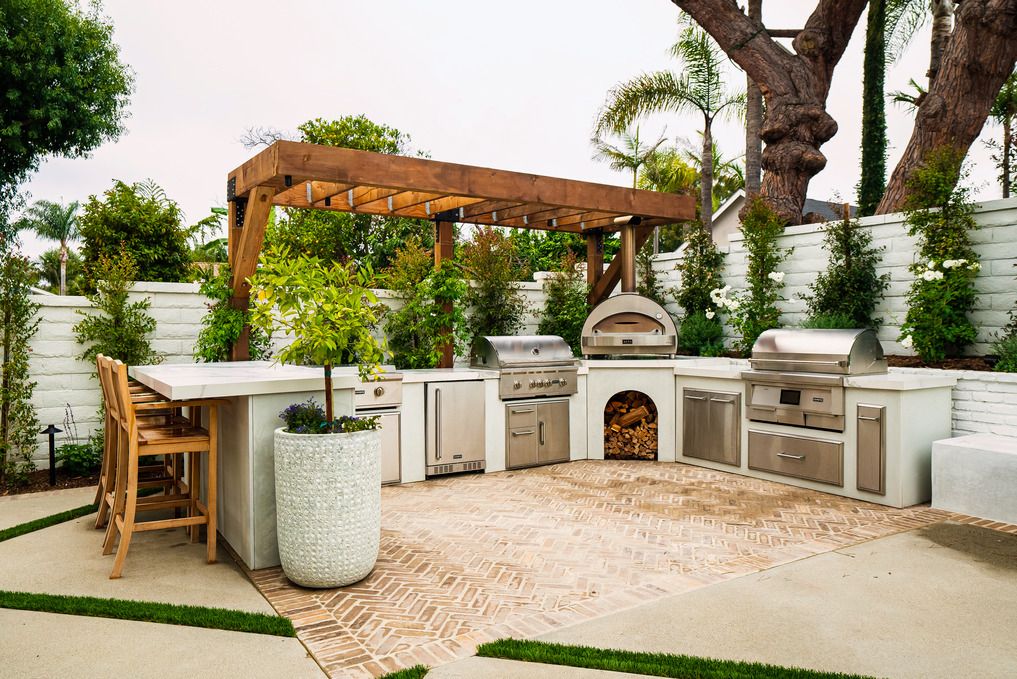
Adding an outdoor kitchen to your property is one of the single most valuable things you can do – both from a financial perspective and a personal enjoyment standpoint. But with so many different considerations to work through, where do you even begin?
Top Considerations for Your Outdoor Kitchen
There’s a lot to think about with a custom outdoor kitchen. Before you start your project, there are several things you’ll want to think through and make key decisions around.
Here are a few:
- Choosing the Right Location
Choosing the ideal location is a really important initial factor for your outdoor kitchen. Consider elements like convenience, functionality, and aesthetics. The kitchen should be easily accessible from your main house to make transporting food and utensils as easy as possible.
Think about the path of the sun throughout the day – it’s typically best to have some shade so you don’t cook under direct sunlight. Additionally, you’ll want to factor wind direction into the equation to avoid smoke from the grill overwhelming your dining area or drifting back into your home.
- Selecting the Type of Outdoor Kitchen
Determine how extensive you want your outdoor kitchen to be. Options range from simple grill stations to fully equipped kitchens with grills, stovetops, refrigerators, and sinks.
As you work through this, think about how you plan to use the space. If you entertain often, a more comprehensive setup might be necessary. However, if you’re mainly interested in family dinners, a simpler configuration will probably suffice.
- Consider a Ready-to-Assemble Approach
There are a variety of ways to build an outdoor kitchen. The two traditional approaches are as follows:
- You can buy standard cabinets and appliances from a local store and have them installed. The benefit of this approach is that it’s inexpensive. The downside is that you can’t customize these to your kitchen. You’re limited by what’s available.
- You can have someone come in and build a custom kitchen onsite, based on your exact specs and measurements. The benefit of this approach is that it’s highly customizable. However, as you might guess – you’re going to pay for this. It gets expensive, so you’ll need to budget for someone’s time and expertise.
While you can build an outdoor kitchen using either of these options, there’s a hybrid approach that offers the best of both worlds: ready-to-assemble kitchens.
With ready-to-assemble kitchens, you can order an outdoor kitchen online using your specifications and measurements. They then ship the individual parts and panels to your house and the custom kitchen can be assembled on site.
“These kitchens are made from high performance concrete panels with the finish fully incorporated into each panel,” explains RTA Outdoor Living, which specializes in these types of kitchens. “These panels are hand-carried into your backyard, bolted into place, and the provided concrete or granite countertop will be placed on top.”
Ready-to-assemble kitchens are a game changer, as they give you a custom kitchen at an “off the shelf” price point. Definitely consider this approach if you have a budget that you have to stay within.
- Choosing Durable Materials
The materials you choose must be able to withstand your specific climate, including changes in temperature, moisture, and exposure to the elements.
- Stainless steel is popular for appliances due to its resistance to rust and corrosion.
- For countertops, granite or glazed tiles are excellent choices because they are durable and can withstand heat and cold.
- For cabinetry, consider marine-grade polymer or teak, which are both resistant to moisture and decay.
- Budgeting and Project Management
A clear budget is key to managing the costs of building an outdoor kitchen, says ElleDecor. Include everything from construction materials and appliances to labor costs. (By the way, It’s wise to set aside an additional 10-20 percent of your budget for unexpected expenses that may arise in the middle of the project.)
- Planning for Utilities
Your outdoor kitchen will need proper utilities, including water, electricity, and possibly gas. Planning their placement is crucial and often requires professional help to ensure safety and compliance with local codes. Make sure utilities are laid out efficiently to keep your outdoor kitchen functional. And, yes, always call your local utility hotline before having anyone dig on your property. You’ll want to know precisely where existing lines are buried.
- Designing for Function and Style
Think about the flow of the space. Your cooking area should be easily accessible from the prep and cleaning stations. Incorporate ample countertop space for food preparation and serving.
For style, coordinate the design of your outdoor kitchen with the exterior of your home to create a cohesive look. As for lighting, include task lighting in cooking areas and softer lighting in dining and socializing areas. You can then complement the overall look with ambient lighting, such as outdoor lanterns, string lights, or even a fireplace or fire pit.
Putting it All Together
Adding an outdoor kitchen to your home is one of the easiest ways to add value and enjoyment to your property. And if you keep the tips from this article in mind, you can make sure you end up with something you love.























